AMERICAN FOOTBALL MONTHLY THE #1 RESOURCE FOR FOOTBALL COACHES
Article CategoriesAFM Magazine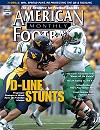
|
Defensive Line Stunts: Proven Ways to Get To The Quarterbackby: Dan Weil© More from this issue Defensive line stunts can be a crucial element to put pressure on the opposing team’s quarterback in pass plays. We talked to two defensive specialists to find out their general philosophy concerning stunts and examples of stunts they like to use. The coaches are Richard Bell, defensive coordinator at the Air Force Academy, and Jeff Smith, co-defensive coordinator and defensive line coach at Urbana University in Urbana, OH. Strategies Bell said the Air Force defense uses stunts to compensate for its lack of size. “We don’t have oversized linemen, so we have to mix our rushes up,” he said. “We can’t depend on a simple four-man rush like Florida State and some other teams. We have to use different things to enable our guys to have a chance at the line of scrimmage to get free, to use their speed. We start with our four linemen. We’ll take the two inside guys and have them twist. Based on the blocking and personnel, we determine who will go first. We call the first guy the penetrator and the second guy the flasher. We generally have a stunt between the two guys on a particular side in a four-man front. We have one in which the inside guy goes first and the outside guy goes on his tail. The inside guy goes across the “b” gap, and the outside guy works to the “a” gap. “Then we switch it. We let the outside guy go first and the inside go second. The guy going inside has a two-way go on the guard or center, so he is not just trapped to one particular gap. That way we can use our speed and quickness.” Smith said Urbana organizes its stunts according to the opposition’s pass protection scheme, generally deploying a 4-2-5 or 4-4-3 formation. “A lot of stunts are rendered ineffective by the nature of the pass protection,” he said. “If they are using a slide or gap protection, the entire line may be working to a gap one away from where the back is going. In that situation it’s very difficult to get to the passer. “Some teams will do play-action or boot protection, protecting the quarterback with a pulling guard to make it look like a run. We try to run stunts on third and long or medium if a team is more pass-oriented than run-oriented. If they take five-step drops with man protection up front, we feel we can be effective. We won’t stunt a lot against three-step drops, play-action, boot protection or rollout protection. We want to stunt against drop-back passing teams.” Smith likes stunts because they allow his defense to pressure the quarterback without the risks entailed by blitzing. THE STUNTS Smith first explained the alignment of his linemen. “We’ll play to the strength side of the play. We’ll have the three-technique strong tackle shaded on the outside shoulder of the guard. The nose tackle is always away from the call. We play him in the shade, which means he’s on the weak side ‘a’ gap but shaded toward the center. We also play him in the one technique, on the inside shade of the guard.” As for the ends, “Against teams that have an open look with no tight ends, we’ll play them in a tilt six technique: the hand of the end is going to be about two feet outside of the outside foot of the offensive tackle. If they play a tight end on the call side, our defensive end will play an eight technique – head up on the tight end. We may play him in a nine technique, tilted off the tight end about one foot outside of his outside leg.” 1. Twist. Urbana’s first stunt is a twist between the nose tackle and the three-technique or strong tackle (See Diagram 1). “The strong tackle will be the first one to enter the ‘a’ gap. He will create a face-off with the offensive guard and work his helmet into the hip of the center. His goal is to be the first one through the gap. We are looking for him to penetrate. He should be the one getting to the QB. 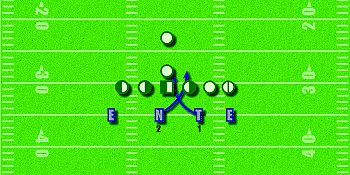 Diagram 1 Twist “We like to play this out of a shade – a weak shade. The nose tackle has a weak shade on the center. His responsibility is to engage the center. He will work on the outside – weak side – of the center to allow the strong tackle to clear through the ‘a’ gap. As he’s engaging the center, out of the corner of his eye he will look for the strong tackle to clear through the ‘a’ gap. “His job is to delay the center. The center and the guard away from the call will help together to block the nose tackle. The nose tackle will then find the first daylight available. He will work up field as soon as they hit that hip to get to the quarterback. If the guard covered by our strong tackle closes down, then the nose tackle will be able to work around that guard and maybe have some free space. “Even though we like to use this against man protection, if we get gap protection going away from our strong tackle, then we can still do it, because there’s an opening for him to get in. We like using it in second and long, because it can work against the run too.” 2. Ram. Bell’s Air Force team also has a stunt that works for running plays as well as passing plays. “It’s a basic one that everybody runs – the Ram stunt,” he said. “Off a five man front, our defensive end over the tackle will come hard via the neck of the guard. If the guard turns out on him, he’ll cross the face of the guard and be in the ‘a’ gap. The linebacker will attack the ‘b’ gap. “The defensive end goes first, and the linebacker next. Then the outside linebacker comes to put pressure on the quarterback and to be the contain guy. If the inside linebacker finds that the ‘b’ gap is congested, then he’ll go outside to daylight. If both the inside and outside linebacker get penetration and end up on the running back, the inside linebacker has to stay to the inside of the back, and the outside linebacker has to be outside the back. That way we don’t have two guys in the same hole or rushing lane.” 3. Thumbs. This Urbana stunt involves the strong defensive tackle and strong end (See Diagram 2). “The job of the strong tackle is a speed rush through the ‘b’ gap where he’s aligned,” Smith said. “He’s the first one through. He has to penetrate. In any pass rush situation, I ask guys to loosen their alignment.” In a normal line-up they will go on the outside shoulder of their offensive counterpart. In a loose alignment, they will put their inside foot on the offensive counterpart’s outside foot. 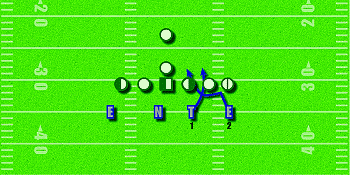 Diagram 2 Thumbs “Thumbs has to be used on passing downs because it has a looser alignment. It’s an exchange of pass rush lanes. The first one through the gap is the strong tackle, who will contain the quarterback. He will keep the up field shoulder of the quarterback inside of him. “Second, the strong end will work into a normal pass rush. We want him to make two to four steps up field and get the offensive tackle to open his hips and set on him hard. We want to try to get the tackle’s shoulders turned and for him to feel that our end is going to work the outside edge hard. Once the tackle has turned his shoulders, our end plants and turns hard to the inside. We tell our guys they have to sell the outside rush hard, or it won’t work. “When our end comes underneath, he wants to find the first daylight to the quarterback. He has no contain responsibility, because he has exchanged lanes with the strong side tackle. He can come as far in as the ‘a’ gap if he has to.” 4. Ears. This is similar to thumbs, but the end goes underneath first (See Diagram 3). “The end plays it exactly the same way as thumbs, but he must understand that he will go first,” Smith said. “If it’s a good offensive tackle he’s going against, it will take four steps before he can go underneath. He wants to exit through the ‘b’ gap. The guy playing strong tackle has to be patient and engage the outside number of the guard. He’ll essentially sit on it. He wants to create an opening for the ‘b’ gap, so that the offensive guard will be occupied by the Bull Rush, leaving an opening for the defensive end who went first. 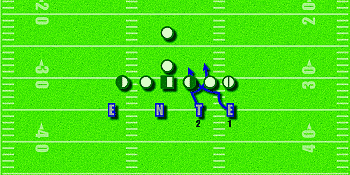 Diagram 3 Ears “Once our tackle sees the defensive end working to clear, he will work to get his helmet into the crease between the outside hip of our end and the inside hip of the offensive tackle. Then you can create a problem for that tackle, because he has to worry about our tackle, giving freedom for the defensive end. Both our end and tackle will hopefully exit through the ‘b’ gap. The whole movement is trying to get the defensive end in free.” 5. Double Thumbs. “This is where we run thumbs on both sides of the ball,” Smith said (See Diagram 4). “We play the weak side nose tackle in a three technique.” 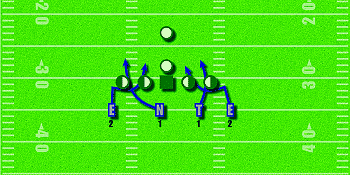 Diagram 4 Double Thumbs 6. Ed. “This is Ears on the weak side,” Smith said (See Diagram 5). “We will play the nose tackle in a three technique just like Double Thumbs.”  Diagram 5 Ed 7. Mix It. “This is Ed on one side and Thumbs on the other,” Smith said (See Diagram 6). “Ed always involves the nose tackle and the end on the weak side. Thumbs always is on the strong side. That helps us against gap and sliding protection. It gives us more of an opportunity of getting to the quarterback than just stunting on one side.” 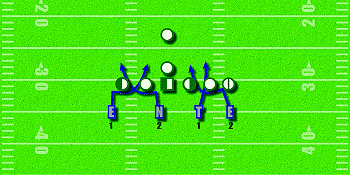 Diagram 6 Mix It Bell’s Falcons also utilize stunts on both sides of the ball. “We try to decide where we can attack their situation the best. We go back and forth on that,” he said. “We have some stunts where we take the inside guy to the front side and cross him all the way over with the outside guy to the backside. “The two inside guys are flashers, and the two outside guys are the penetrators. The flashers can get up field. So we get into a twist incorporating not only our two inside guys but also our two outside guys. In some situations, with tight linemen and splits, we have to give our guys a chance to get to the passer. The outside guy on the left side is twisting with the inside guy on the right, and the outside guy on the right is twisting with the inside guy on the left. That gives us the maximum amount of movement.” |
|
| HOME |
MAGAZINE |
SUBSCRIBE | ONLINE COLUMNISTS | COACHING VIDEOS |
Copyright 2024, AmericanFootballMonthly.com
All Rights Reserved




